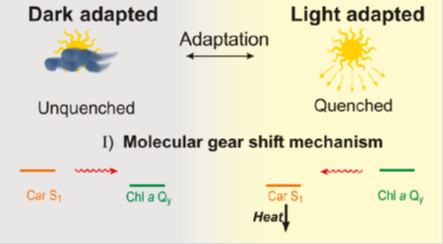Polyenes such as carotenoids often play a crucial role in native pigment protein complexes, for instance, in photosynthetic light-harvesting complexes. For example, it is generally assumed that they play a pivotal role in regulating the flow of energy in the photosynthetic apparatus under varying light irradiation conditions. However, the exact molecular mechanism is still under debate.

One difficulty in addressing the involvement of polyenes in energy transfer processes is the fact that their first excited state, S1, is optically forbidden, i.e. it is neither contributing to their absorption spectrum and is the reason why polyenes are in general rather non-fluorescent. For example the orange color of many carotenoids, for example, is only due to the absorption of the second excited state in the blue spectral region. However, after excitation of polyenes via the second excited state, the optically forbidden, first excited state is very quickly populated within a few hundreds of femtoseconds. In general, this optical forbidden state plays a very important role to understand photophysical processes in particular in the presence of the class of tetrapyrrole molecules. They have very similar first excited state energies and include also molecules such as Chlorophylls. Experimentally, it is known from many studies that quite effective energy transfer between the optical forbidden first excited state of polyenes and tetrapyrrole molecules is possible. An approach to gain more insight in the involvement of the first excited state of polyenes in the involvement in the energy flow to tetrapyrroles is two-photon excitation. This is possible since the optical selection rules are different for two-photon excitation. Considerations of the symmetry of the orbitals involved show that the first excited state of polyenes is actually two-photon excitable. In the figure one of the most simplistic system is shown that directly demonstrates the information gained from this approach. It shows the fluorescence intensity observed from the tetrapyrolle compound phtalocyanine (PCs) in directly connected to carotenoids of different conjugation length. The data show a comparison of the PC fluorescence observed upon one-photon excitation (OPE) at absorption wavelengths (black) corresponding to direct PC excitation and upon two-photon excitation (TPE) using wavelengths corresponding the first excited state energies of the carotenoids (RED).

The results clearly demonstrate that the fluorescence observed from PC upon two-photon excitation, FTPE, of carotenoids containing nine double bonds and covalently linked to the PC (9DB dyad) is significantly higher than that of PC alone (Pc1). One-photon excitation of both compounds yield very similar fluorescence intensities, FOPE, demonstrating that the fluorescence quantum yield of PC is affected only very little by the presence of the carotenoid. Considering limited carotenoid to PC energy transfer and the reduction in the fluorescence quantum yield of PC to about 90 % (compare FOPE for Pc1 and the 9DB dyad) the relative intensities observed after TPE with and without carotenoids demonstrate that at the chosen TPE-wavelength the probability of selectively exciting the dark state of the carotenoids is ~80% whereas the probability of direct tetrapyrolle two-photon excitation is correspondingly smaller. In the compound in which PC is linked to a carotenoid containing eleven double bonds (11DB dyad) the fluorescence quantum yield of PC is much lower due to efficient energy transfer from PC to the non-fluorescing carotenoid. These data quantify the differences in two-photon excitation efficiency of polyenes and tetrapyrrols and demonstrate the expected signals observed in the presence of energy transfer either towards the polyenes or the tetrapyrolls in very well defined systems.
[1] A. Pieper, M. Hohgardt, M. Willich, D. A. Gacek, N. Hafi, D. Pfennig, A. Albrecht, P. J. Walla, "Biomimetic light-harvesting funnels for re-directioning of diffuse light", Nat. Commun., 9, 666 (2018).
[2] D. A. Gacek, A. L. Moore, T. A. Moore, P. J. Walla, "Two-Photon Spectra of Chlorophylls and Carotenoid–Tetrapyrrole Dyads", J. Phys. Chem. B, 121 (43), 10055-10063 (2017).
[3] P.-N. Liao, S. Pillai, D.Gust, T.A. Moore, A.L. Moore, and P.J. Walla, "Two-photon study on the electronic interactions between the first excited singlet states in carotenoid-tetrapyrrole dyads", J. Phys. Chem. A, 115, 4082-4091 (2011).
The Study contains also further valuable insights into the question how bidirectional energy transfer may play a role in carotenoid-tetrapyrol interactions.
[4] L. Wilk, M. Grunwald, P.-N. Liao, P. J. Walla, W. Kühlbrandt,"Direct interaction of the major light-harvesting complex II and PsbS in nonphotochemical quenching", PNAS, 110, 5452-5456 (2013).
[5] S. Bode, C. C. Quentmeier, P. N. Liao, N. Hafi, T. Barros, L. Wilk, F. Bittner, P. J. Walla "On the regulation of photosynthesis by excitonic interactions between carotenoids and chlorophylls", PNAS, 106, 30, 12311-12316 (2009).
[6] P. J. Walla, P. A. Linden, C.–P. Hsu, G. D. Scholes and G. R. Fleming,"Femtosecond dynamics of the forbidden carotenoid S1 state in light-harvesting complexes of purple bacteria observed after two-photon excitation", Proc. Natl. Acad. Sci. 97, 10808–-0813 (2000).
Research Groups
Hohm Group
Jacob Group
Kozuch Group
Maul Group
Proppe Group
Tschierlei Group
Walla Group
Associated Groups
Muñoz Group (GRS)
Emeriti
Becker Group
Gericke Group
Personnel
Institute Director
Executive Board
Staff
Facilities
Workshop
School lab (G)
Agnes Pockels lab
Documents
Institute Rules (G)
Operation Manuals
Laser safety
Emergency leaflet
Campus Map (G)
Events Calendar (G)
TU Public Announcements
Whistle Blowing (G)
Ticket GITZ (G)
Ticket Facilities Management (G)
Energy Web Portal (G)
(G) German only
